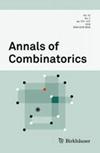大型随机树中双子树可能的最大尺寸
IF 0.7
4区 数学
Q4 MATHEMATICS, APPLIED
引用次数: 0
摘要
如果有根树的一对顶点不相交的诱导子树的顶点数和外度数相同,我们就称它们为孪生树。我们研究了大小为 \(n\rightarrow \infty \)的均匀随机有根 Cayley 树中孪生树的最大可能大小。结果表明,大小为((2+\delta)\sqrt{log n\cdot \log \log n}\)的孪生树的预期数量趋近于零,而大小为((2-\delta)\sqrt{log n\cdot \log \log n}\)的孪生树的预期数量趋近于无穷大。本文章由计算机程序翻译,如有差异,请以英文原文为准。
The Likely Maximum Size of Twin Subtrees in a Large Random Tree
We call a pair of vertex-disjoint, induced subtrees of a rooted tree twins if they have the same counts of vertices by out-degrees. The likely maximum size of twins in a uniformly random, rooted Cayley tree of size \(n\rightarrow \infty \) is studied. It is shown that the expected number of twins of size \((2+\delta )\sqrt{\log n\cdot \log \log n}\) approaches zero, while the expected number of twins of size \((2-\delta )\sqrt{\log n\cdot \log \log n}\) approaches infinity.
求助全文
通过发布文献求助,成功后即可免费获取论文全文。
去求助
来源期刊

Annals of Combinatorics
数学-应用数学
CiteScore
1.00
自引率
0.00%
发文量
56
审稿时长
>12 weeks
期刊介绍:
Annals of Combinatorics publishes outstanding contributions to combinatorics with a particular focus on algebraic and analytic combinatorics, as well as the areas of graph and matroid theory. Special regard will be given to new developments and topics of current interest to the community represented by our editorial board.
The scope of Annals of Combinatorics is covered by the following three tracks:
Algebraic Combinatorics:
Enumerative combinatorics, symmetric functions, Schubert calculus / Combinatorial Hopf algebras, cluster algebras, Lie algebras, root systems, Coxeter groups / Discrete geometry, tropical geometry / Discrete dynamical systems / Posets and lattices
Analytic and Algorithmic Combinatorics:
Asymptotic analysis of counting sequences / Bijective combinatorics / Univariate and multivariable singularity analysis / Combinatorics and differential equations / Resolution of hard combinatorial problems by making essential use of computers / Advanced methods for evaluating counting sequences or combinatorial constants / Complexity and decidability aspects of combinatorial sequences / Combinatorial aspects of the analysis of algorithms
Graphs and Matroids:
Structural graph theory, graph minors, graph sparsity, decompositions and colorings / Planar graphs and topological graph theory, geometric representations of graphs / Directed graphs, posets / Metric graph theory / Spectral and algebraic graph theory / Random graphs, extremal graph theory / Matroids, oriented matroids, matroid minors / Algorithmic approaches
 求助内容:
求助内容: 应助结果提醒方式:
应助结果提醒方式:


